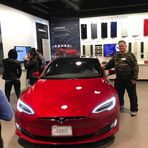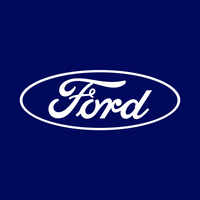The Electric Dream: Ford's Setback and Cadillac's Renaissance
May 7, 2025, 4:21 am

Location: United States, Texas, Austin
Employees: 10001+
Founded date: 2003
Total raised: $3.86B

Location: United States, Michigan, Ypsilanti
Employees: 10001+
Founded date: 1896
Total raised: $40K
In the heart of Detroit, the automotive landscape is shifting. Ford Motor Company, once a titan of innovation, has stumbled. The company recently scrapped its ambitious project to develop a next-generation electrical architecture, known as FNV4. This system was envisioned as the brain of modern vehicles, a digital nerve center designed to streamline operations and enhance the driving experience. The goal was clear: to compete with electric vehicle (EV) pioneers like Tesla. However, this dream has turned into a nightmare.
Ford's decision to halt the FNV4 project is a significant blow. The company had poured substantial resources into this initiative, aiming to create a fully-networked vehicle that could cut costs and improve quality. The failure to deliver on this promise raises questions about Ford's ability to keep pace with rivals like General Motors and Stellantis. In an industry where speed is the ultimate currency, Ford's setback feels like a missed opportunity.
The FNV4 system was supposed to revolutionize how vehicles operate. It aimed to replace complex wiring with a zonal system, where smaller software brains would manage specific functions while communicating with a central hub. This would not only reduce manufacturing costs but also allow for rapid over-the-air updates. The potential for enticing customers with subscription-based features was also on the table. Yet, the dream has crumbled, leaving Ford grappling with losses that totaled nearly $10 billion over the past two years.
The challenges of developing such advanced electrical systems are immense. They require not just software expertise but also significant hardware investments. The intricate wiring harnesses, likened to "copper anacondas," are a logistical nightmare. Ford's CEO, Jim Farley, had expressed optimism about the project's potential, but now the company must regroup and rethink its strategy.
While Ford faces uncertainty, General Motors is charting a different course. Cadillac, GM's luxury brand, is on a mission to reclaim its status as the quintessential American luxury car. The stakes are high. Luxury vehicles offer higher profit margins and cater to affluent customers who view them as status symbols. Cadillac's revival is not just about sales; it's about restoring a legacy.
The journey to revive Cadillac has been long and arduous. GM President Mark Reuss has taken a personal interest in the brand, viewing it as a cornerstone of American luxury. The company has faced fierce competition from established players like BMW and Mercedes-Benz, as well as new entrants like Tesla. Yet, Cadillac is determined to rise from the ashes.
Cadillac's strategy hinges on a clear vision. The brand aims to focus on all-electric vehicles, sporty sedans, and its flagship Escalade. This approach is designed to elevate Cadillac's status and improve residual values. The brand's leadership recognizes that consistency is key. After years of missteps, Cadillac is finally finding its footing.
The introduction of the all-electric Lyriq marked a significant milestone for Cadillac. This vehicle represents a shift towards a fully electric future, with plans to phase out gas-powered models by 2030. The Celestiq, a bespoke luxury vehicle priced at $300,000, is the crown jewel of Cadillac's lineup. However, production delays have plagued its launch, forcing GM to relaunch the vehicle with improved software capabilities.
Despite the challenges, Cadillac is experiencing a resurgence. Sales in North America have surged, with an 18% increase reported in the first quarter of this year. The brand's focus on American-made vehicles gives it a competitive edge over foreign luxury brands. However, the situation in China is less rosy. Once Cadillac's largest market, sales in China have plummeted as domestic brands gain traction.
The contrasting fortunes of Ford and Cadillac highlight the complexities of the automotive industry. Ford's failure to innovate in the electric space could have long-term repercussions. Meanwhile, Cadillac's revival is a testament to the power of vision and strategy. The brand is not just selling cars; it's selling a lifestyle, a promise of luxury and performance.
As the automotive landscape continues to evolve, the stakes are higher than ever. Companies must adapt or risk being left behind. Ford's setback serves as a cautionary tale, while Cadillac's renaissance offers a glimmer of hope. The road ahead is fraught with challenges, but for those willing to embrace change, the journey can lead to extraordinary destinations.
In this race for the future, speed is not just an advantage; it's a necessity. The electric dream is alive, but it requires unwavering commitment and innovation. As Ford recalibrates its strategy, Cadillac marches forward, determined to reclaim its throne in the luxury market. The battle for the hearts and wallets of consumers is just beginning, and the outcome remains uncertain. In this high-stakes game, only the bold will thrive.
Ford's decision to halt the FNV4 project is a significant blow. The company had poured substantial resources into this initiative, aiming to create a fully-networked vehicle that could cut costs and improve quality. The failure to deliver on this promise raises questions about Ford's ability to keep pace with rivals like General Motors and Stellantis. In an industry where speed is the ultimate currency, Ford's setback feels like a missed opportunity.
The FNV4 system was supposed to revolutionize how vehicles operate. It aimed to replace complex wiring with a zonal system, where smaller software brains would manage specific functions while communicating with a central hub. This would not only reduce manufacturing costs but also allow for rapid over-the-air updates. The potential for enticing customers with subscription-based features was also on the table. Yet, the dream has crumbled, leaving Ford grappling with losses that totaled nearly $10 billion over the past two years.
The challenges of developing such advanced electrical systems are immense. They require not just software expertise but also significant hardware investments. The intricate wiring harnesses, likened to "copper anacondas," are a logistical nightmare. Ford's CEO, Jim Farley, had expressed optimism about the project's potential, but now the company must regroup and rethink its strategy.
While Ford faces uncertainty, General Motors is charting a different course. Cadillac, GM's luxury brand, is on a mission to reclaim its status as the quintessential American luxury car. The stakes are high. Luxury vehicles offer higher profit margins and cater to affluent customers who view them as status symbols. Cadillac's revival is not just about sales; it's about restoring a legacy.
The journey to revive Cadillac has been long and arduous. GM President Mark Reuss has taken a personal interest in the brand, viewing it as a cornerstone of American luxury. The company has faced fierce competition from established players like BMW and Mercedes-Benz, as well as new entrants like Tesla. Yet, Cadillac is determined to rise from the ashes.
Cadillac's strategy hinges on a clear vision. The brand aims to focus on all-electric vehicles, sporty sedans, and its flagship Escalade. This approach is designed to elevate Cadillac's status and improve residual values. The brand's leadership recognizes that consistency is key. After years of missteps, Cadillac is finally finding its footing.
The introduction of the all-electric Lyriq marked a significant milestone for Cadillac. This vehicle represents a shift towards a fully electric future, with plans to phase out gas-powered models by 2030. The Celestiq, a bespoke luxury vehicle priced at $300,000, is the crown jewel of Cadillac's lineup. However, production delays have plagued its launch, forcing GM to relaunch the vehicle with improved software capabilities.
Despite the challenges, Cadillac is experiencing a resurgence. Sales in North America have surged, with an 18% increase reported in the first quarter of this year. The brand's focus on American-made vehicles gives it a competitive edge over foreign luxury brands. However, the situation in China is less rosy. Once Cadillac's largest market, sales in China have plummeted as domestic brands gain traction.
The contrasting fortunes of Ford and Cadillac highlight the complexities of the automotive industry. Ford's failure to innovate in the electric space could have long-term repercussions. Meanwhile, Cadillac's revival is a testament to the power of vision and strategy. The brand is not just selling cars; it's selling a lifestyle, a promise of luxury and performance.
As the automotive landscape continues to evolve, the stakes are higher than ever. Companies must adapt or risk being left behind. Ford's setback serves as a cautionary tale, while Cadillac's renaissance offers a glimmer of hope. The road ahead is fraught with challenges, but for those willing to embrace change, the journey can lead to extraordinary destinations.
In this race for the future, speed is not just an advantage; it's a necessity. The electric dream is alive, but it requires unwavering commitment and innovation. As Ford recalibrates its strategy, Cadillac marches forward, determined to reclaim its throne in the luxury market. The battle for the hearts and wallets of consumers is just beginning, and the outcome remains uncertain. In this high-stakes game, only the bold will thrive.
